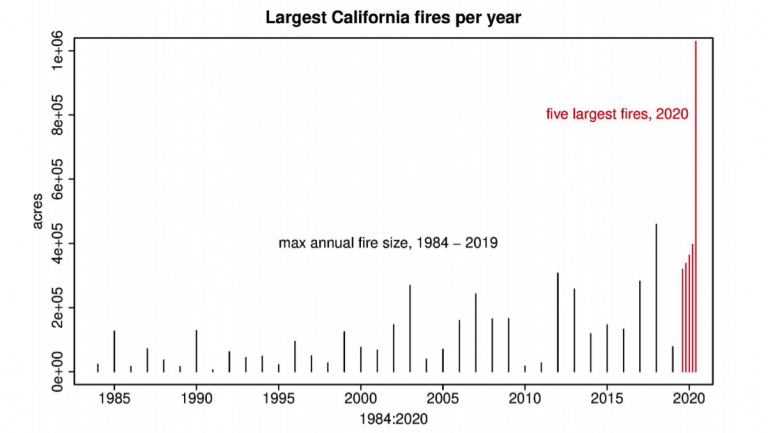Well-known climate scientist Dr. Leroy Westerling – from U.C. Merced – recently presented at the October meeting of the Amador Calaveras Consensus Group (ACCG) with grim predictions based on the latest fire research data and long-term modeling simulations.
This year’s extreme wildfires have been a strong match with Dr. Westerling’s past scientific modeling predictions for the Sierra Nevada region and for California overall. Below you will find some highlights from his ACCG presentation that are especially important for those concerned about the future of our region’s forests:
1. California’s wildfire season has been increasing in length and intensity over recent decades. The graphic below shows that in the range of years prior to 2000 (shown in green) the average acres burned in California in a given year dramatically decreased after wildifires peaked in September. Over recent years (shown in red) there is no longer the same drop-off in the amount of acres burned. Wildfires burning in October and November are now resulting in exceptionally high numbers of average annual acres burned. In sharp contrast with past cooler climate years, fires since 2001 are continuing to burn late into the fall and have greatly increased the amount of acres burned in recent decades.

2. A second jaw-dropping fact that Dr. Westerling shared was that exceptionally large fires have become more frequent rather than only being an extremely rare event. Besides the 2018 Mendocino Complex - which burned 459,000 acres - the five largest fires in California history occurred just THIS YEAR! So over a century of historic records, the six largest fires have all burned in just the past three years. The largest wildfire in the State’s history is the gigantic August Complex Fire, which (at the time of this article being posted) has burned more than a million acres in Northern California.

The 2013 Rim Fire (which burned a large portion of the Stanislaus Forest and Yosemite National Park) was the fifth largest fire prior to the 2020 fire season, but now that 300 square-mile wildfire has dropped down to the 10th largest in California history!
3. Another interesting point raised by Dr. Westerling’s studies showed how giant wildfires create levels of emissions that are “off the scale” compared to normal pollution levels and the levels produced my medium or small fires. As of 2018, the 15 largest fires in California were modeled to have created an exceptional amount of total air emissions of California during the years that they burned. The 4,000,000 acres that have burned in California in 2020 have combined to cumulatively create another exceptional pulse of air quality emissions. The record-breaking fire size of events across California and the West this year has resulted in smoke plumes that have stretched across North America and beyond - greatly increasing overall carbon emissions of California.
Fire modeling research like Dr. Westerling’s can help to identify where forest health treatments should be prioritized to be most effective and also where specific regions in the future may be most likely to burn at high severity.
If you want to see more of Dr. Westerling’s presentation you can find it at this URL: https://acconsensus.org/wp-content/uploads/2019/11/04-Forest-Fire-Research-and-Simulations-for-the-Fifth-California-Climate-Assessment.pdf

